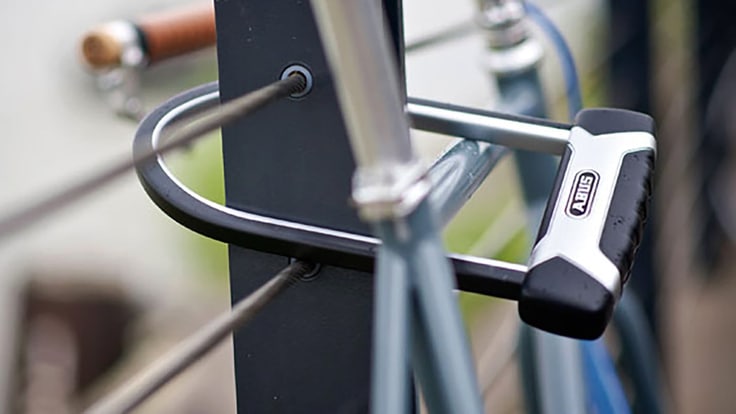All bike locks can be broken, but a sturdy lock and savvy locking strategy will greatly reduce the risk of your bike being singled out by thieves.
U-Locks
This widely used bike lock style is an excellent deterrent. The bulky locking mechanism resists hammers, chisels and the like. Its horseshoe shape can limit leveraging—provided it's not way oversized for the bike. The goal is to reduce the amount of space in which a thief can insert a crowbar and leverage enough oomph to pop it apart.
U-locks come in various sizes. Your goal is to size the lock so that it goes around the things you're locking with as little gap left as possible. Small to medium models lock one wheel and your frame to a fixed object. Large models lock both wheels and your frame to a fixed object.
Cable Locks
These are versatile and adaptable but generally offer less theft deterrence than U-locks. Bolt cutters are able to cut through most cable locks. On their own, they may be suitable for low-crime areas. Elsewhere, they are a good choice to use in combination with a U-lock to secure easily removed parts (e.g., seat). Many have integral combination or key locks; others require a separate padlock. Some feature sliding sizing or an armored coating. A few newer models feature stylish designs.
Chain Locks
Tough enough for high-crime areas, these bike locks use a specially designed chain link that resists hacksaws or chisels and makes the chain tough to leverage. Be sure to invest in a padlock that's just as sturdy—thieves can easily cut through thin locks, no matter how sturdy the chain. The downside? Chains are heavy and bulky, so they are best for stationary uses.
Locking Wheel/Seat Skewers
Quick-release wheels and seatposts are, unfortunately, as convenient for thieves as they are for bike owners. Great for high-crime areas, locking skewers disable the quick-release feature and make it a lot tougher to steal. They're easy to install but many require a special wrench that comes with the skewer.
Bike Lock Keys and Combinations
Keyed locks use either flat keys or cylindrical keys. Cylindrical keys got a bad reputation in years past when it was discovered some locks of this style could be picked by a ballpoint pen. Newer models have solved that problem so now either style is equally effective.
Keyed bike locks usually come with at least 2 keys so you'll have a backup. Most bike lock makers have a key replacement program if you lose your keys.
Keyed locking mechanisms are found on most U-locks and some cable and chain locks.
Combination locks are convenient because you don't have to remember to carry a key with you or worry about losing keys, but you do have to remember a 4-digit code.
Cable locks typically use a combination locking mechanism.
